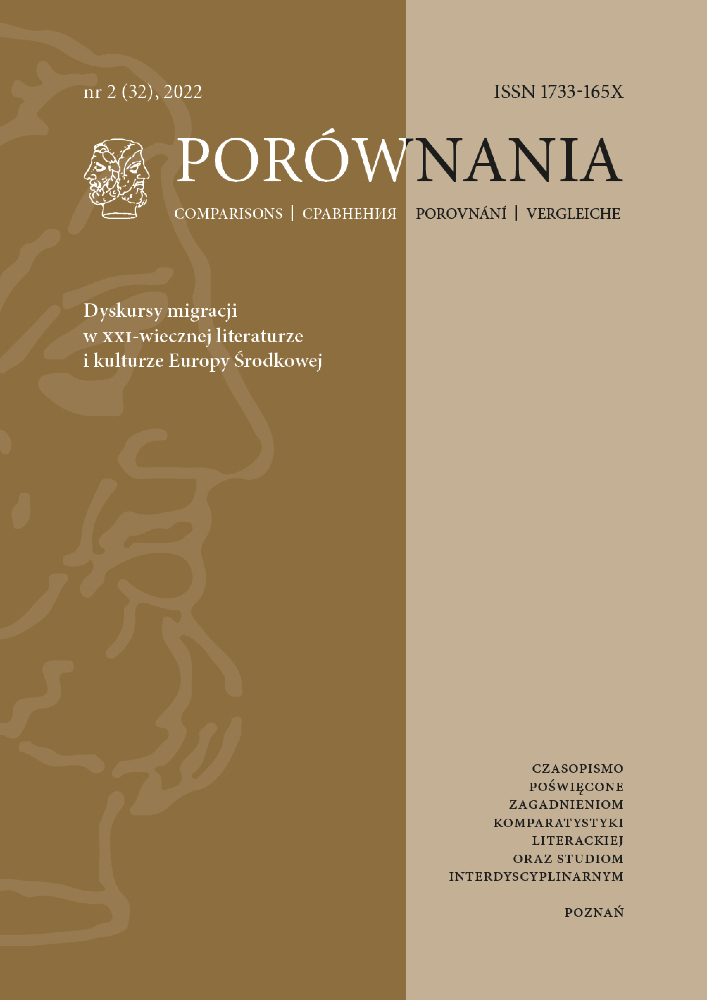Povzetek
Od 2016 roku na polskim rynku wydawniczym dla dzieci pojawiło 26 tytułów dotyczących przymusowych migrantów. Ich obecność powiązana jest ściśle z narastającym od 2015 roku kryzysem polityki migracyjnej w Europie, który na przestrzeni minionych lat coraz mocniej dotykał Polskę. Kolejne fazy kryzysu azylowego wyznaczonego przez kryzys na granicy polsko-białoruskiej (2019) oraz wojnę w Ukrainie (2022) wywoływały różne reakcje wydawców dla dzieci. Celem artykułu jest zbadanie związku między dominującym dyskursem nt. uchodźców, dystansem przestrzennym od kryzysu oraz dystansem kulturowym od przymusowych migrantów a aktywnością wydawców dla dzieci w zakresie publikacji książek dotyczących kryzysu azylowego. Analiza segmentu rynku dla dzieci w latach 2015–2022 uwzględniająca wymienione parametry prowadzi do wniosku, że książka dla dzieci jest przestrzenią intensywnego napięcia ideologicznego, przebiegającego na linii między wielkimi i małymi wydawnictwami.
Literatura
„Ola, Borys i nowi przyjaciele” – wyjątkowa bajka dla dzieci z Ukrainy, https://tinyurl.com/23dje9k4 [dostęp: 14.09.2022].
Biernacka-Licznar Katarzyna, Jamróz-Stolarska Elżbieta, Paprocka Natalia (2018), Lilipucia rewolucja. Awangardowe wydawnictwa dla dzieci i młodzieży w Polsce w latach 2000–2015. Produkcja wydawnicza. Bibliografia, Wydawnictwo SBP, Warszawa.
Davies Nicola (2016), The Day the war Came – a poem about unaccompanied child refugees, „The Guardian” 28.04., https://tinyurl.com/tm8knjah [dostęp: 7.07.2022].
Dolan Anne M. (2014), Intercultural Education, Picturebooks and Refugees: Approaches for Language Teachers, „CLELEjournal”, t. 2, z. 1, s. 92–109.
Ekatarina Strekalova-Hughes (2019), Unpacking Refugee Flight: Critical Content Analysis of Picturebooks Featuring Refugee Protagonists, „International Journal of Multicultural Education” t. 21, nr 2, s. 23–44. DOI: https://doi.org/10.18251/ijme.v21i2.1871 DOI: https://doi.org/10.18251/ijme.v21i2.1871
Fornalczyk-Lipska Anna (2018), Linguistic and visual represenattions of war in picture books, „Kwartalnik Neofilologiczny”, nr 1, s. 60–73.
Gawryluk Ewa (2022), Moc Amelki, il. Aleksandra Krzanowska, Wydawnictwo Literatura, Łódź, Wojny dorosłych – historie dzieci.
Hope Julia (2017), Children’s Literature about Refugees. A Catalyst in the Classroom, UCL Institute of Education Press, University College London, London.
Ilu uchodźców z Ukrainy jest w Polsce (2022), https://300gospodarka.pl/news/uchodzcy-z-ukrainy-w-polsce-liczba [dostęp: 25.08.2022].
Ilu uchodźców z Ukrainy przebywa w Polsce pół roku po rozpoczęciu inwazji? (2022), https://tinyurl.com/5dtb9exx [dostęp: 25.08.2022].
Johnson Holly, Gasiewicz Becca (2017), Examining Displaced Youth and Immigrant Status through Critical Multicultural Analysis, w: Critical content analysis of Children’s and young adult iteraturę. Reframing Perspective, red. Holly Johnson, Janelle Mathis, Kathy G. Short, Routledge, New York, s. 29–43.
Kostecka Weronika (2017), Once Upon a Time There Was a War: The Use of Fairy-tale Conventions in Contemporary Polish Literature for Children about Refugees, „Maska”, nr 36, s. 33–49.
„Małe Charaktery” bez patronatu fundacji dziecięcych po cenzurze bajki Kasdepkego, https://tinyurl.com/v88eb4k6 [dostęp: 25.08.2022].
Modlitwa do morza, https://tinyurl.com/2uxcfvph [dostęp: 24.08.2022].
Pietrusińska Maria Jadwiga (2020), Reprezentacje uchodźców polskiej literaturze dziecięcej –przykład dyskursu prouchodźczego, „Studia Migracyjne. Przegląd Polonijny”, nr 1 (175), s. 47–66. DOI: https://doi.org/10.4467/25444972SMPP.20.003.11794 DOI: https://doi.org/10.4467/25444972SMPP.20.003.11794
Pietrzak Maciej (2017), Rząd zakazał Sopotowi przyjęcia 10 sierot z Aleppo, „Dziennik Bałtycki”, 3.02, https://tinyurl.com/2822ukfa [dostęp: 24.08.2022].
Przeprosiny (2022), „Mały Charakter” nr 3, s. 1.
Ruch Wydawniczy w Liczbach. Książki (2017), nr 63, https://www.bn.org.pl/download/document/1535452662.pdf [dostęp: 20.08.2022].
Ryrych Katarzyna (2022), Wojna w Kuropatkach, il. Sylwia Szyrszeń, Wydawnictwo Literatura, Łódź, Wojny dorosłych – historie dzieci.
Sung Yoo Kyung, Fahrenbruck Mary L., Lopez-Robertson Julia (2017), Using Intertextuality to Unpack Representations of Immigration in Children’s Literature, w: Critical content analysis of Children’s and young adult literature. Reframing Perspective, red. Holly Johnson, Janelle Mathis, Kathy G. Short, Routledge, New York, s. 44–60.
Świetlicki Mateusz (2020), Such Books Should be Burned! SameSex Parenting and the Stretchable Defnition of the Family in Larysa Denysenko’s and Mariia Foya’s Maya and Her Mums, „Children’s Literature in Education”, t. 51, s. 534–543. DOI: https://doi.org/10.1007/s10583-019-09394-5 DOI: https://doi.org/10.1007/s10583-019-09394-5
Licenca
Avtorske pravice (c) 2022 Magdalena Bednarek

To delo je licencirano pod Creative Commons Priznanje avtorstva-Brez predelav 4.0 mednarodno licenco.
Utwory opublikowane w czasopiśmie „Porównania”, na platformie Pressto należącej do Uniwersytetu im. Adama Mickiewicza w Poznaniu są udostępniane na licencji Creative Commons Uznanie autorstwa - Bez utworów zależnych 4.0 Międzynarodowe (CC BY-ND 4.0)
Tym samym wszyscy zainteresowani są uprawnieni do korzystania z utworów opublikowanych pod następującymi warunkami:
-
uznania autorstwa — czyli obowiązek podania wraz z rozpowszechnianym utworem informacji o autorstwie, tytule, źródle (odnośniki do oryginalnego utworu, doi) oraz samej licencji
-
bez utworów zależnych — remiksując, przetwarzając lub tworząc na podstawie utworu, nie wolno rozpowszechniać zmodyfikowanych treści.
-
brak dodatkowych ograniczeń — nie można korzystać ze środków prawnych lub technologicznych, które ograniczają innych w korzystaniu z utworu na warunkach określonych w licencji.
Uniwersytet im. Adama Mickiewicza w Poznaniu zachowuje prawo do czasopisma jako całości (układ, forma graficzna, tytuł, projekt okładki, logo itp.).
Autor zachowuje prawa majątkowe, ale udziela zgody Uniwersytetowi im. Adama Mickiewicza w Poznaniu na wykorzystanie dzieła. Autorzy tekstów zakwalifikowanych do publikacji proszeni są o wypełnienie podpisanie i przesłanie umowa (PL) agreement (EN)
Agreement for granting a royalty-free license to works with a commitment to grant a CC sub-license





